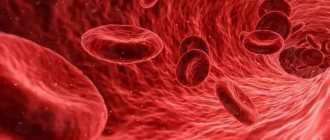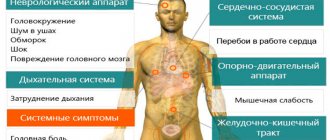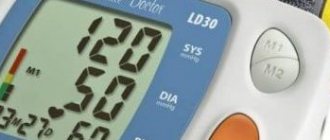Signs of excess potassium
Not only a lack of potassium, but also too much potassium is dangerous.
Symptoms resemble microelement deficiency, so it is advisable to get tested
In such cases, the following symptoms occur
:
- increased excitability of the nervous system, irritability, anxiety;
- sweating;
- weakness;
- cardiopsychoneurosis;
- intestinal colic;
- frequent urination.
A healthy person should not worry about a possible overdose. Normally, excess microelement is excreted through the kidneys.
If a person is diagnosed with hyperkalemia, he is sent for examination.
The causes of excess potassium are
:
- renal failure;
- hemolytic anemia;
- malignant tumors;
- dehydration;
- anaphylactic shock;
- hypofunction of the adrenal cortex (Addison's disease).
If potassium levels are elevated, it is recommended to limit potassium-rich foods.
Targeted nutrition tips
that will increase your energy level by 10 out of 10
From TOP nutritionists of the MIIN
Get tips
Blood calcium is elevated, other tests have been taken - how to decipher them?
Of course, deciphering a blood test is the prerogative of the attending endocrinologist, and independent study of one’s blood test can lead the patient to diagnostic errors, however, within the framework of this article, we will give some information about the possible results of a laboratory examination for elevated blood calcium. Use the information obtained with caution and remember that it is not a substitute for consultation with a medical specialist.
So, possible options for laboratory results and their interpretation.
Blood calcium is increased, parathyroid hormone is increased, phosphorus is decreased, calcitonin is normal, calcium in daily urine is increased
– most likely, we are talking about primary hyperparathyroidism and the presence of a parathyroid adenoma. Additional examination is necessary using ultrasound of the thyroid gland and neck, scintigraphy of the parathyroid glands with technetril, and in some cases, computed tomography of the neck. It is treated surgically (endoscopic surgery through an incision about 2 cm long is possible in a specialized center).
Parathyroid hormone is elevated, calcium is normal, phosphorus is normal, calcitonin is normal
– with a high degree of probability we are talking about secondary hyperparathyroidism due to a banal deficiency of vitamin D in the blood. It is treated by taking vitamin D and calcium. It is important to exclude a laboratory error associated with an underestimation of the level of ionized calcium in the blood (it is better to retake the test for ionized calcium in a specialized laboratory of the endocrinology center).
Calcium in the blood is increased, parathyroid hormone is normal, phosphorus is normal, calcitonin is normal
– a neuroendocrine tumor that produces PTH-like peptides or forms lytic metastases in the bone should be suspected. Examination and treatment depend on the type of tumor detected.
High calcium in the blood (usually slightly increased calcium is observed), parathyroid hormone is moderately increased, phosphorus is normal, calcitonin is normal, calcium concentration in daily urine is reduced
– we can talk about a rare familial disease, the so-called familial benign hypocalciuric hypercalcemia. This disease is accompanied by a change in the sensitivity of cellular receptors to parathyroid hormone and impaired calcium excretion in the urine. Does not require treatment and is not dangerous. Often, inexperienced doctors diagnose primary hyperparathyroidism in such cases and refer the patient to unnecessary surgery to remove a non-existent parathyroid adenoma.
Ionized calcium is increased, total calcium is normal, parathyroid hormone is increased
– we are usually talking about parathyroid adenoma.
Ionized calcium is elevated, total calcium is below normal
– laboratory error must be excluded. The analysis should be re-taken in a specialized laboratory.
Ionized calcium in the blood is increased, parathyroid hormone is increased, calcitonin is increased
– the patient should be suspected of having both a parathyroid adenoma and medullary thyroid cancer. Together, these two diseases indicate a high probability that the patient has type IIA multiple endocrine neoplasia syndrome - a rare hereditary pathology transmitted in the family and leading to the development of three dangerous tumors: medullary thyroid cancer, parathyroid adenomas (usually multiple), pheochromocytoma (tumor adrenal gland, which produces adrenaline or norepinephrine). Urgent consultation with an endocrinologist or endocrinologist surgeon is required!
Calcium in the blood is elevated during the first test, I want to retake the test - what is the best way to do this?
If you want to check whether your blood calcium is really elevated and are going to take a second blood test, follow some important rules that will help the second test be as accurate as possible:
1. a blood test should be taken only in a specialized laboratory using high-quality equipment;
2. a blood test must be taken only on an empty stomach;
3. if you are taking vitamin D or calcium supplements (or combination medications with vitamin D and calcium), stop them at least 2-3 days before your blood test; the entry of calcium from the drug into the blood can lead to an increased calcium level in the blood - of course, in this case a falsely elevated calcium is detected.
Indications for testing potassium levels
Potassium functions as an immunomodulator, resists hypoxia, and lowers blood pressure. A deficiency of a microelement provokes a malfunction of almost all internal organs; an excess leads to cardiac arrest.
A potassium test is necessary for all patients with diseases of the cardiovascular system, when taking antitumor or anti-inflammatory drugs. Indications for taking a test for potassium in the blood are: kidney pathologies of various origins, adrenal insufficiency, hypertension, arrhythmia. Monitoring the level of microelement is mandatory when undergoing hemodialysis, treatment with cardiac glycosides and diuretics.
How to determine the level of potassium in the body
Today you can independently determine the level of potassium in the body by passing a special test developed by a group of doctors and scientists under the leadership of Professor Olga Gromova.
How to do it:
- answer the test questions, identify the signs from column 1;
- write the value of this characteristic in column 3;
- multiply the value in column 2 by the value in column 3 and write the total in column 4;
- add the results of each row of column 4;
- add 71 to the resulting total
| Sign | Point | Your attribute value | Result (value in column 2 multiplied by value in column 3) |
| 1 | 2 | 3 | 4 |
| Blood pressure within normal range (Yes = 1, No = 0) | +6 | ||
| Feeling good (Yes = 1, No = 0) | +2 | ||
| Taking multivitamins in courses, at least 2 times a year (Yes = 1, No = 0) | +1.5 | ||
| Age in years | -0.2 | ||
| Number of ARVI cases per year | -0.5 | ||
| Lack of regular physical activity: brisk walking, swimming, cycling, etc. for at least 30 minutes. daily (Yes = 1, No = 0) | -1 | ||
| Daily alcohol consumption (more than 30 ml/day ethanol) (Yes = 1, No = 0) | -2 | ||
| Regular consumption of refined foods (confectionery, chips, sugar, lemonade, etc.) (Yes = 1, No = 0) | -2 | ||
| “Putting” symptom (the desire to support the head with a hand due to fatigue of the neck and back muscles) (No = 0; Yes (1 time/day) = 1, Yes (2-3 times/day) = 2, Yes (more than 3 -x times/day) = 3) | -2 | ||
| Cramps of the calf muscles (No = 0; Yes (1 time/day) = 1, Yes (2-3 times/day) = 2, Yes (more than 3 times/day) = 3) | -2 | ||
| Do you have hemorrhoids? (Yes = 1, No = 0) | -2 | ||
| In women: abdominal tenderness, headache before menstruation (Yes = 1, No = 0) | -2.5 | ||
| Dark circles around the eyes (Yes = 1, No = 0) | -3 | ||
| Frequent pain in the lumbosacral region (sciatica) (Yes = 1, No = 0) | -5 | ||
| Hyperacusis (hypersensitivity to sounds, feeling “everything is very loud”) (Yes = 1, No = 0) | -7 | ||
| Total in points (sum of all values in column 4) | |||
| Forecast of potassium concentration in erythrocytes (add 71 to the Total in points, taking into account the “+” or “-” sign) |
If the calculated potassium level is at the lower limit or below normal (70–120 mmol/l), you need to consult a doctor to find out the causes of potassium deficiency and replenish it.
What prevents it from being absorbed?
Maintaining a stable internal environment in the body mainly depends on the balance of potassium and sodium, so a deficiency of the former can be caused by excess consumption of the latter. As a rule, potassium deficiency due to an excess of sodium
develops in those who like to heavily salt their food and consume large amounts of canned food, smoked meats and pickles.
Potassium is excreted from the body during intense physical exertion, in hot climates and during profuse sweating during illness. Potassium is also actively excreted
with the constant use of laxatives and diuretics, including in weight loss medications. Potassium balance should be monitored by those who take hormonal medications or adhere to a strict diet. Alcohol consumption or a lack of magnesium in the body greatly harms potassium absorption.
What foods contain potassium?
All products containing potassium (K) are usually classified taking into account the concentration of this useful mineral in them:
- low-potassium (100 mg of component per 100 g of product);
- with an average potassium content (150-200 mg per 100 g);
- with a high potassium content (260-400 mg per 100 g);
- saturated with potassium (more than 400 mg per 100 g).
Plant sources of potassium
Products of plant origin are a real storehouse of useful potassium compounds. Among them there is a wide variety of vegetables, fruits and berries containing this mineral.
For example, potassium in fruits is perfectly absorbed, since the combination of glucose and insulin is very effective, which promotes the transfer of potassium into cells.
Vegetables and fruits contain a lot of potassium and little sodium.
Potassium content in nuts and seeds:
| The product's name | Potassium content per 100g |
| Peanut | 658 mg |
| Walnut | 474 mg |
| Dried acorns | 709 mg |
| Pine nut | 597 mg |
| Cashew | 553 mg |
| Sesame | 497 mg |
| Almond | 748 mg |
| Sunflower seeds (seeds) | 647 mg |
| Pistachios | 1025 mg |
| Hazelnut | 445 mg |
Potassium content in cereals and grain products:
| The product's name | Potassium content per 100g |
| Buckwheat (grain) | 325 mg |
| Buckwheat (prodel) | 320 mg |
| Buckwheat (kernel) | 380 mg |
| Corn grits | 147 mg |
| Semolina | 130 mg |
| Oatmeal | 362 mg |
| Pearl barley | 172 mg |
| Wheat groats | 230 mg |
| Millet groats (polished) | 211 mg |
| Rice groats | 100 mg |
| Barley groats | 205 mg |
| Sweet corn | 270 mg |
| Pasta made from 1st grade flour | 178 mg |
| Premium flour pasta | 123 mg |
| Buckwheat flour | 577 mg |
| Corn flour | 147 mg |
| Oat flour | 280 mg |
| Oat flour (oatmeal) | 351 mg |
| Wheat flour 1st grade | 176 mg |
| Wheat flour 2 grades | 251 mg |
| Premium wheat flour | 122 mg |
| Wheat flour | 310 mg |
| Peeled rye flour | 600 mg |
| Rye wallpaper flour | 396 mg |
| Seeded rye flour | 200 mg |
| Rice flour | 50 mg |
| Oats (grain) | 421 mg |
| Oat bran | 566 mg |
| Wheat bran | 1260 mg |
| Wheat (grain, soft variety) | 337 mg |
| Wheat (grain, durum) | 325 mg |
| Rice (grain) | 314 mg |
| Rye (grain) | 424 mg |
| Oat flakes "Hercules" | 330 mg |
| Barley (grain) | 453 mg |
Potassium content in legumes:
| The product's name | Potassium content per 100g |
| Peas (shelled) | 731 mg |
| Green peas (fresh) | 285 mg |
| Mash | 1000 mg |
| Chickpeas | 968 mg |
| Soybean (grain) | 1607 mg |
| Beans (grain) | 1100 mg |
| Green beans) | 260 mg |
| Lentils (grain) | 672 mg |
Potassium content in fruits, berries, dried fruits:
| The product's name | Potassium content per 100g |
| Apricot | 305 mg |
| Avocado | 485 mg |
| Quince | 144 mg |
| Cherry plum | 188 mg |
| A pineapple | 321 mg |
| Orange | 197 mg |
| Watermelon | 110 mg |
| Banana | 348 mg |
| Cowberry | 90 mg |
| Grape | 225 mg |
| Cherry | 256 mg |
| Blueberry | 51 mg |
| Pomegranate | 150 mg |
| Grapefruit | 184 mg |
| Pear | 155 mg |
| Dried pear | 872 mg |
| Durian | 436 mg |
| Melon | 118 mg |
| Blackberry | 208 mg |
| Strawberries | 161 mg |
| Raisin | 830 mg |
| Fresh figs | 190 mg |
| Dried figs | 710 mg |
| Kiwi | 300 mg |
| Cranberry | 119 mg |
| Gooseberry | 260 mg |
| Dried apricots | 1717 mg |
| Lemon | 163 mg |
| Raspberries | 224 mg |
| Mango | 168 mg |
| Mandarin | 155 mg |
| Cloudberry | 180 mg |
| Nectarine | 201 mg |
| Sea buckthorn | 193 mg |
| Papaya | 182 mg |
| Peach | 363 mg |
| Dried peach | 2043 mg |
| Pomelo | 216 mg |
| Red rowan | 230 mg |
| Rowan chokeberry | 158 mg |
| Plum | 214 mg |
| White currant | 270 mg |
| Red currants | 275 mg |
| Black currant | 600 mg |
| Dried apricots | 1781 mg |
| Feijoa | 172 mg |
| Dates | 370 mg |
| Persimmon | 200 mg |
| Cherries | 233 mg |
| Blueberry | 51 mg |
| Prunes | 864 mg |
| Rose hip | 23 mg |
| Apples | 278 mg |
| Dried apples | 580 mg |
Potassium content in vegetables and herbs:
| The product's name | Potassium content per 100g |
| Basil (greens) | 295 mg |
| Eggplant | 238 mg |
| Swede | 238 mg |
| Ginger (root) | 415 mg |
| Zucchini | 238 mg |
| White cabbage | 300 mg |
| Broccoli | 316 mg |
| Brussels sprouts | 600 mg |
| Kohlrabi cabbage | 370 mg |
| Red cabbage | 302 mg |
| Cabbage | 238 mg |
| Savoy cabbage | 238 mg |
| Cauliflower | 210 mg |
| Potato | 568 mg |
| Cilantro (greens) | 521 mg |
| Watercress (greens) | 606 mg |
| Dandelion leaves (greens) | 397 mg |
| Green onion (feather) | 259 mg |
| Leek | 225 mg |
| Bulb onions | 175 mg |
| Carrot | 200 mg |
| Sea kale | 970 mg |
| Cucumber | 141 mg |
| Fern | 370 mg |
| Parsnip (root) | 529 mg |
| Sweet pepper (Bulgarian) | 163 mg |
| Parsley (greens) | 800 mg |
| Parsley (root) | 342 mg |
| Pomodoro (tomato) | 290 mg |
| Rhubarb (greens) | 325 mg |
| Radish | 255 mg |
| Black radish | 357 mg |
| Turnip | 238 mg |
| Lettuce (greens) | 220 mg |
| Beet | 288 mg |
| Celery (greens) | 430 mg |
| Celery (root) | 393 mg |
| Asparagus (greens) | 196 mg |
| Jerusalem artichoke | 200 mg |
| Pumpkin | 204 mg |
| Dill (greens) | 335 mg |
| Horseradish (root) | 579 mg |
| Garlic | 260 mg |
| Spinach (greens) | 774 mg |
| Sorrel (greens) | 500 mg |
Animal products containing potassium
Do not neglect animal products - they also contain potassium reserves.
Potassium content in meat, fish and seafood:
| The product's name | Potassium content per 100g |
| Vobla | 160 mg |
| Pink salmon | 335 mg |
| Red granular caviar | 90 mg |
| Pollock caviar | 60 mg |
| Black granular caviar | 80 mg |
| Squid | 280 mg |
| Flounder | 320 mg |
| Chum salmon | 335 mg |
| Baltic sprat | 380 mg |
| Caspian sprat | 600 mg |
| Shrimp | 220 mg |
| Bream | 265 mg |
| Atlantic salmon (salmon) | 420 mg |
| Mussels | 310 mg |
| Pollock | 420 mg |
| capelin | 290 mg |
| Meat (lamb) | 270 mg |
| Meat (beef) | 326 mg |
| Meat (turkey) | 210 mg |
| Meat (rabbit) | 335 mg |
| Meat (chicken) | 194 mg |
| Meat (fatty pork) | 230 mg |
| Meat (pork meat) | 285 mg |
| Meat (broiler chickens) | 236 mg |
| Navaga | 335 mg |
| Sea bass | 300 mg |
| River perch | 280 mg |
| Sturgeon | 280 mg |
| Halibut | 450 mg |
| Beef liver | 277 mg |
| Haddock | 300 mg |
| Beef kidneys | 237 mg |
| Crayfish | 250 mg |
| Carp | 280 mg |
| Salaka | 210 mg |
| Fatty herring | 310 mg |
| Lean herring | 31 mg |
| Medium salted herring | 215 mg |
| Mackerel | 280 mg |
| Som | 240 mg |
| Horse mackerel | 600 mg |
| Zander | 280 mg |
| Cod | 340 mg |
| Tuna | 600 mg |
| Acne | 230 mg |
| Oyster | 220 mg |
| Hake | 335 mg |
| Pike | 260 mg |
Potassium content in dairy products and egg products:
| The product's name | Potassium content per 100g |
| Acidophilus | 145 mg |
| Chicken egg white | 152 mg |
| Cheese cheese (from cow's milk) | 95 mg |
| Varenets 2.5% | 144 mg |
| Chicken egg yolk | 129 mg |
| Yogurt 1.5% | 152 mg |
| Yogurt 3.2% | 147 mg |
| Kefir | 146 mg |
| Kumis (mare's milk) | 77 mg |
| Low-fat kumiss (from cow's milk) | 146 mg |
| Milk | 146 mg |
| Goat milk | 204 mg |
| Yogurt 2.5% | 144 mg |
| Ryazhenka | 146 mg |
| Cream 10% | 124 mg |
| Cream 20% | 109 mg |
| Cream 35% | 90 mg |
| Sour cream 10% | 124 mg |
| Sour cream 15% | 116 mg |
| Sour cream 20% | 109 mg |
| Sour cream 25% | 100 mg |
| Sour cream 30% | 95 mg |
| Cheese "Adygei" | 70 mg |
| Cheese "Dutch" 45% | 100 mg |
| Camembert cheese | 75 mg |
| Parmesan cheese | 92 mg |
| Cheese "Poshekhonsky" 45% | 95 mg |
| Cheese "Roquefort" 50% | 110 mg |
| Cheese "Russian" 50% | 88 mg |
| Sulguni cheese" | 100 mg |
| Chees Feta" | 62 mg |
| Cheddar cheese 50% | 116 mg |
| Swiss cheese 50% | 100 mg |
| Gouda cheese | 121 mg |
| Cottage cheese 18% (fat) | 112 mg |
| Cottage cheese 2% | 78 mg |
| Cottage cheese 4% | 112 mg |
| Cottage cheese 5% | 112 mg |
| Chicken egg | 140 mg |
| Quail egg | 144 mg |
Among all the listed products, we will highlight the TOP products in terms of potassium content, availability, ease of preparation and absorption by the body. Food products containing potassium in large quantities
- Potato
One medium potato contains 900 mg of potassium. By eating just one potato as a side dish for lunch, you can get a little more than 1/5 of your daily potassium requirement. To absorb potassium, give preference to baked potatoes.
Potatoes also contain vitamin C, vitamin B6, iron, and fiber (especially in the skin). When cooled, potato starch nourishes beneficial intestinal microflora.
- Sun-dried tomatoes
Fresh tomatoes also contain potassium. But there is much more of it in dried tomatoes or tomato paste. It is better to prepare these products yourself or choose them in a store with a good composition - without added sugar and preservatives.
We recommend
"Can food heal people: the power of good nutrition" Read more
A cup of these tomatoes contains 1,800 mg of potassium, which is about 40% of the daily recommended amount.
In addition, tomatoes contain a lot of fiber, vitamin C, vitamin E, improve the digestive and immune system and are good for the heart.
- Beans
Red and white beans are equally beneficial for the body. One cup of red beans contains 600 mg, white beans - 1,000 mg. Beans are high in fiber, protein and iron. It can be added to soups and salads.
- Dried apricots
The concentration of nutrients contained in fresh apricots increases when dried. Therefore, 100 grams of dried apricot contains 1.162 mg of potassium.
- Prunes
In addition to potassium (686 mg in ½ cup), prunes contain vitamins B1, B2, C, magnesium, phosphorus and iron.
- Avocado
One avocado contains approximately 975 mg of potassium, as well as magnesium, phosphorus, iron, zinc, various vitamins and healthy fats, which are so important for heart health and good skin condition.
- Salmon
In 100 grams you can find 420 mg of potassium - this is more than in any other fish. In addition, red fish is rich in omega-3 and vitamin D.
- Spinach
An excellent side dish for fish and meat dishes, as well as a frequent ingredient in the most delicious smoothies, it contains 774 mg of potassium per 100 grams.
- Pumpkin
There are many varieties of pumpkin, and the amount of potassium depends on this. For example, 100 grams of cooked acorn squash contains 437 mg, and winter squash contains 448 mg.
- Oranges
In addition to vitamin C and B vitamins, folic acid, oranges also contain potassium. With one glass of juice you will get about 473 mg of potassium.








